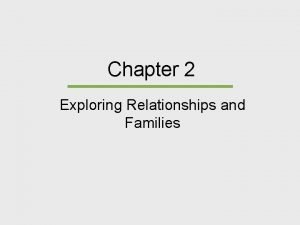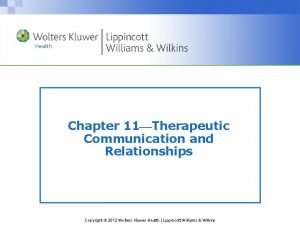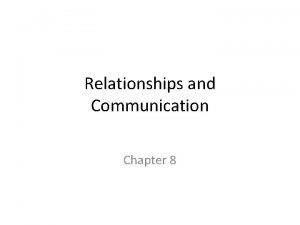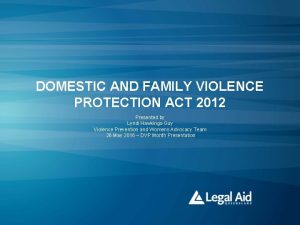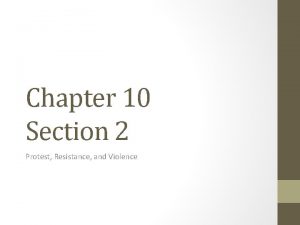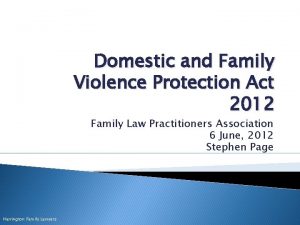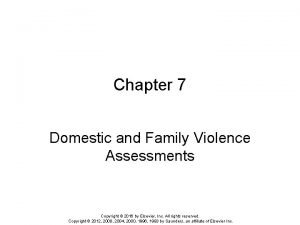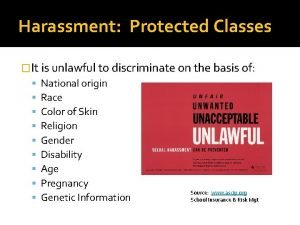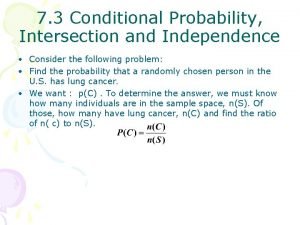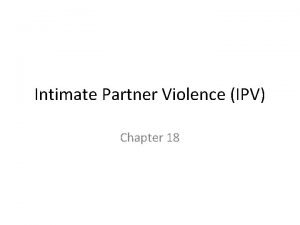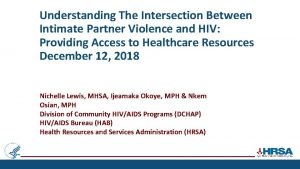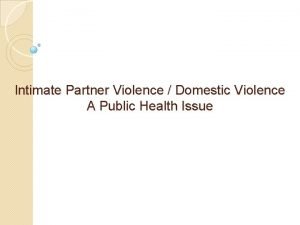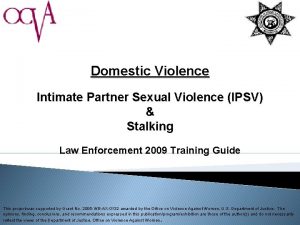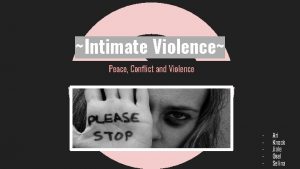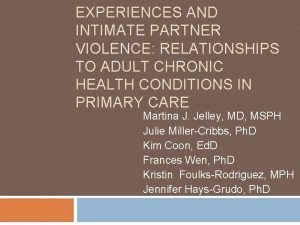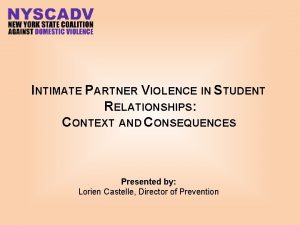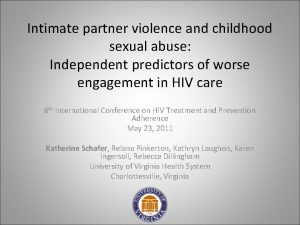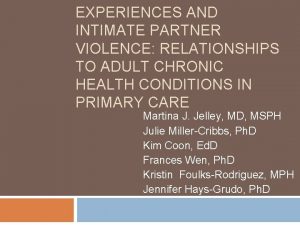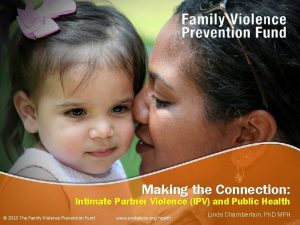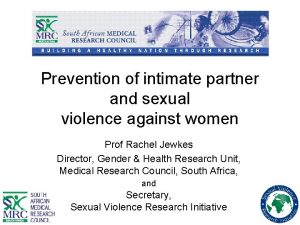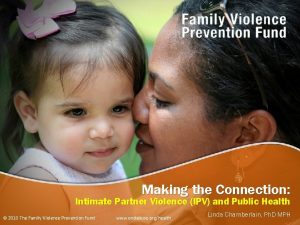The Intersection of Intimate Partner Violence and HIV











































- Slides: 43

The Intersection of Intimate Partner Violence and HIV: Detection, Disclosure, and Implications for Treatment Adherence Tami P. Sullivan, Ph. D Associate Professor of Psychiatry Yale School of Medicine New Haven, Connecticut Slide 1 of XX

Financial Relationships With Commercial Entities Dr Sullivan has no relevant financial affiliations to disclose. Her spouse is employed by and holds stock and stock options in Achillion Pharmaceuticals. (Updated 11/12/18) Slide 2 of XX

Learning Objectives After attending this presentation, learners will be able to: � Identify signs of various types of intimate partner violence (IPV) � Describe the extent to which IPV may impact patients’ abilities to engage in care and follow through with treatment recommendations � Create a context/environment that supports the engagement of victims of IPV and fosters positive wellbeing

Learning Objectives After attending this presentation, learners will be able to: �Identify signs of various types of intimate partner violence (IPV) �Describe the extent to which IPV may impact patients’ abilities to engage in care and follow through with treatment recommendations. �Create a context/environment that supports the engagement of victims of IPV and fosters positive wellbeing.

Myths? Misconceptions? Misunderstandings? �Victims are fragile, helpless women who have been abused by angry, mean, psychopathic men who could easily be identified in one interaction with them. �Victims are severely physically abused, have extremely low self esteem, and fear for their lives on a daily basis.

Intimate Partner Violence (IPV) The use or attempted use of physical, sexual, verbal, emotional, economic, or other forms of abusive behavior with the intent to harm, threaten, intimidate, control, isolate, restrain or monitor another person. �Physical – Grabbing, pushing, hitting, punching, choking/arm against neck �Sexual – Experiencing unwanted sexual behaviors (verbal coercion through use of force) �Psychological – Belittling remarks, put downs, threats, monitoring whereabouts, restricting contact

Daily Experiences of Intimate Partner Violence

ARS You’re a woman in a relationship with a male partner who has physically abused you. Over a 3 -month period, what percentage of your days are characterized by the occurrence of some form of IPV? 1. 90% 2. 38% 3. 12% 4. 62%

Daily Patterns of Co-occurrence (2, 778 days) Category of (co)-occurrence Freq of days % 1, 724 62. 1 Psychological IPV only 754 27. 1 Psychological and Physical 177 6. 3 Psychological, Physical and Sexual 64 2. 3 Psychological and Sexual 33 1. 2 Sexual IPV only 18 0. 6 Physical IPV only 8 0. 3 Physical and Sexual 0 0. 0 No IPV

Implications The finding that, on most days, no IPV occurred may help to explain the ambivalence some (women) experience about ending their relationships. The “breaks” in between incidents of IPV contribute to minimizing problems in the relationship and instilling hope that partners will change their abusive behavior.

Implications �Findings are in contrast to presentations of IPV in popular culture media that most often depict severely physically abused women. �Such presentations do not accurately represent all (women) who experience IPV and may do a disservice to the range of women, children and families who could benefit from or are in need of assistance. �Findings underscore the importance of attending to psychological IPV.

IPV and HIV – What’s the Connection?

What percentage of female IPV victims live with HIV? 1. 45% 2. 38% 3. 10% 4. 65%

Intersection – Prevalence Women who experience IPV are more likely to become infected with HIV than women not in abusive relationships. �Victims are 48% more likely to be infected with HIV than non-victims. ~ 10% of women currently experiencing IPV are living with HIV. �That’s almost 10 times the prevalence among women in the general population. Abusive partners can increase HIV risk for women �For example, partners are HIV positive, engaging in risky sexual behavior, injecting drugs, and/or forcing victims to have sex without protection.

What percentage of women living with HIV experience IPV? 1. 82% 2. 05% 3. 15% 4. 55%

Intersection – Prevalence �About 55% of women living with HIV experience IPV – That’s double the IPV prevalence among women in the general population. �Women with HIV have been beaten and killed by their partners upon disclosure of their HIV status – 24% of female patients experienced abuse by their partners after disclosing their HIV status

DOES IPV MATTER TO HIV TREATMENT PLANNING AND ADHERENCE?

Specialty-Specific Example: What do you screen for? OB/GYNs: Do you routinely screen for gestational diabetes or preeclampsia? �Abuse is more common for pregnant women than gestational diabetes or preeclampsia.

Women’s Own Words: 4 Themes about How IPV Affects Care (1) Partners actively interfere in HIV care: “He used to fight with me and make me not take my medicines…” “Well it got to a point where you don’t want me to go nowhere, you know…” (2) Partners passively interfere in HIV care: � “Sometimes � “…he’ll he would get mad at me and not take me to my appointments. “ forget… Well, he says he forgets. ”

(3) Women’s self worth is so affected by IPV that they don’t engage in self care: – “When I was with my ex-boyfriend, I didn’t take good care of myself. But as soon as I got out of that relationship, it’s like everything fell in place. I started dressing more, taking care of my health. ” – “No, I wanted to stop myself [from taking the HIV medications] so, like, that I could die. That’s how bad my nerves were. What I was going through, I just wanted to like die slowly. ” – “I got hooked into him. I stopped taking care of me and started taking care of him. ”

(4) Physical harm may impact relationships with service providers: – “Sometimes, it was always, I was bruised. And then, I like I said, I didn’t want anyone to see that. And I had refused to call the police. So I guess I was dodging the doctor, the police, and everything. ”

Barriers to disclosure �Shame/Stigma (concealable) �Fear (blame, social disconnection, children) �Gender/race/sexual orientation �Previous disclosure experiences �Invested in the relationship �“Not serious enough” �Potential mismatch of goals �Don’t need the kind of help you can provide �Media influence

Do victim/survivors want you to screen? Approximately 8 out of 10 victims said they would like their healthcare providers to ask them privately about IPV

Victims who talked to their health care provider… �Were 4 times more likely to use an intervention �Were 2. 6 times more likely to exit the abusive relationship Health Care Providers Make a Difference!

SHOULD YOU SCREEN FOR IPV?

�Screen for current/past IPV, only when you are prepared to respond. �The goal doesn’t have to be detection/the victim’s disclosure: – therefore, options other than direct screening exist.

Direct Screening U. S. Preventive Services Task Force (2018) recommends screening and referral to ongoing support services. �Direct screening with an instrument such as: – – – Humiliation, Afraid, Rape, Kick (HARK); Hurt, Insult, Threaten, Scream (HITS); Extended Hurt, Insult, Threaten, Scream (E-HITS); Partner Violence Screen (PVS); Woman Abuse Screening Tool (WAST) �Evidence was for women of child-bearing age; no evidence for elders or men.


Detection Isn’t Always the Goal National Network to End Domestic Violence IPVhealthpartners. org – Futures Without Violence

CUES C: Confidentiality �Always see the patient alone for part of the visit and disclose your limits of confidentiality before discussing IPV. UE: Universal Education + Empowerment �Use safety cards to talk with all patients about healthy and unhealthy relationships and the health effects of violence. Give at least 2 cards to each patient so that they can share with friends and family. S: Support �Disclosure is not the goal, but it will happen. Discuss a patientcentered care plan to encourage harm reduction. Make a warm referral to your DV partner and document the disclosure in order to follow up at the next visit. www. IPVhealthpartners. org

Safety Card approach "We’ve started talking to all our patients about partner violence so they know how to get help for themselves and so they can help others. ”

"I've started giving two of these cards to all of my patients—in case it’s ever an issue for you because relationships can change and also for you to have the information so you can help a friend or family member if its an issue for them. ”

�Open the card and do a quick review: "It talks about healthy and safe relationships, ones that aren’t and how they can affect your health. ”



“On the back of the card there is a safety plan and 24/7 hotlines that have folks who really understand complicated relationships. ”

Discussion Approach to Detection �Normalize the topic and ask nonjudgmentally: – “Since I am your doctor, we need to have a good partnership. I can better understand your health if you would answer some questions about your relationship history. ” – “I ask all of my patients this question because it is important for me to know what has gone on in their lives. ” – “Everyone argues at home. What happens when you and your partner disagree? ”

If Someone Discloses �“I am sorry this is happening. It is not okay, but it is common. You are not alone. ” �“What you’re telling me makes me worried about your safety and health. ”

Evaluate the patient and circumstances �If your patient discloses, – Evaluate current level of danger, violence, substance use, and general well-being.

Support the patient, but do avoid acting as a therapist. �“Do you have someone to talk to for support? ” �“Would you like me to explain options and resources that survivors are often interested in hearing about? ” �“Some survivors find talking to an advocate or counselor to be helpful. ” �“What else can I do to be helpful? Is there another way I can be helpful? ” *In most states, mandatory reporting requirements do not apply to IPV victims unless they are children, elders or vulnerable.

�If your patient does not disclose or says, “no” – Offer education and prevention information. – Ask/assess again at future visits.

Clinic Model 1. Support staff 2. Connect IPV to health 3. Safety card intervention (Futures Without Violence. org) 4. Have a protocol for warm referral and support

Question-and-Answer
 The spyware used in intimate partner violence
The spyware used in intimate partner violence Define the relationship chapter 15
Define the relationship chapter 15 Intimate family chapter 7
Intimate family chapter 7 Intimate family chapter 7
Intimate family chapter 7 Intimate distance is:
Intimate distance is: Intimate family chapter 6
Intimate family chapter 6 Intimate family chapter 6
Intimate family chapter 6 Meaning of initmacy
Meaning of initmacy Intimate family chapter 2
Intimate family chapter 2 Consultative register examples
Consultative register examples Dewgarden foaming intimate wash benefits
Dewgarden foaming intimate wash benefits Intimate zone in communication
Intimate zone in communication Intimate zone in communication
Intimate zone in communication Intimate antonym
Intimate antonym 01 me line intimate
01 me line intimate Relationship guidelines chapter 8
Relationship guidelines chapter 8 The impact of incarceration on intimate relationships
The impact of incarceration on intimate relationships A bacterial std that usually affects mucous membranes
A bacterial std that usually affects mucous membranes Chapter 24 sexually transmitted diseases and hiv/aids
Chapter 24 sexually transmitted diseases and hiv/aids Habit as a modifier of human act
Habit as a modifier of human act Domestic and family violence protection act 2012
Domestic and family violence protection act 2012 Gandhi king and mandela what made non-violence work dbq
Gandhi king and mandela what made non-violence work dbq Chapter 9 resolving conflicts and preventing violence
Chapter 9 resolving conflicts and preventing violence Chapter 27 anger aggression and violence
Chapter 27 anger aggression and violence Chapter 10 section 2 protest resistance and violence
Chapter 10 section 2 protest resistance and violence S68r family law act
S68r family law act Chapter 9 resolving conflicts and preventing violence
Chapter 9 resolving conflicts and preventing violence Rising tide chapter
Rising tide chapter Framework agreement on harassment and violence at work
Framework agreement on harassment and violence at work Chapter 7 domestic and family violence assessment
Chapter 7 domestic and family violence assessment Workplace violence and harassment quiz answers
Workplace violence and harassment quiz answers Chapter 10 section 2 protest resistance and violence
Chapter 10 section 2 protest resistance and violence Academy on violence and abuse
Academy on violence and abuse Probability union and intersection
Probability union and intersection Irrational numbers venn diagram
Irrational numbers venn diagram Intersection of square prism and cylinder
Intersection of square prism and cylinder P(a given b) formula
P(a given b) formula Geometry coach points lines and planes
Geometry coach points lines and planes How to simplify unions and intersections
How to simplify unions and intersections Dc load line
Dc load line Efficient private matching and set intersection
Efficient private matching and set intersection Closure property of cfl
Closure property of cfl The intersection of the wbs and the obs is called the
The intersection of the wbs and the obs is called the Wbs and obs intersection
Wbs and obs intersection








